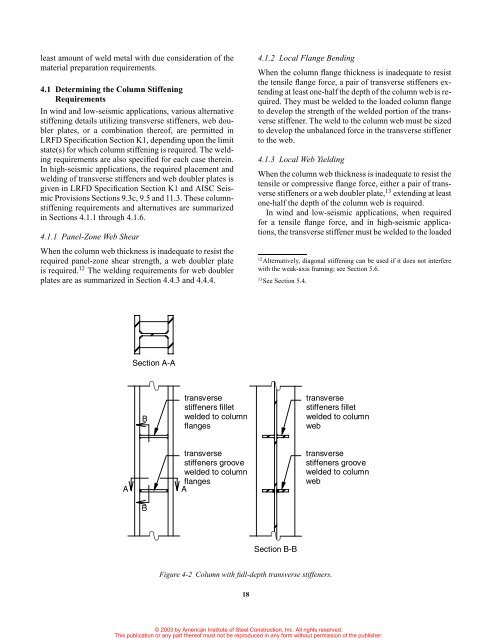AISC Design Guide 13..
AISC Design Guide 13..
AISC Design Guide 13..
You also want an ePaper? Increase the reach of your titles
YUMPU automatically turns print PDFs into web optimized ePapers that Google loves.
least amount of weld metal with due consideration of the 4.1.2 Local Flange Bending<br />
material preparation requirements.<br />
When the column flange thickness is inadequate to<br />
resist<br />
the tensile flange force, a pair of transverse stiffeners extending<br />
at least one-half the depth of the column web is re-<br />
4.1 Determining the Column Stiffening<br />
Requirements<br />
quired. They must be welded to the loaded column flange<br />
In wind and low-seismic applications, various alternative to develop the strength of the welded portion of the transstiffening<br />
details utilizing transverse stiffeners, web dou-<br />
verse stiffener. The weld tothe column web must be sized<br />
bler plates, or a combination thereof, are permitted in todevelop the unbalanced force in the transverse stiffener<br />
LRFD Specification Section K1, depending upon the limit to<br />
the web.<br />
state(s) for which column stiffening is required. The welding<br />
requirements are also<br />
specified for each case therein. 4.1.3 Local Web Yielding<br />
In high-seismic applications, the required placement and<br />
When the column web thickness is inadequate toresist the<br />
welding of transverse stiffeners and web doubler plates is<br />
tensile or compressive flange force, either a pair of transgiven<br />
in LRFD Specification Section K1 and <strong>AISC</strong> Seisverse<br />
stiffeners or a web doubler plate,<br />
13<br />
extending at least<br />
mic Provisions Sections 9.3c, 9.5 and 11.3. These column-<br />
the depth of the column web is required.<br />
one-half<br />
stiffening requirements and alternatives are summarized<br />
In wind and low-seismic applications, when required<br />
in Sections 4.1.1 through 4.1.6.<br />
for a tensile flange force, and in high-seismic applications,<br />
4.1.1 Panel-Zone Web Shear<br />
the transverse stiffener must be welded tothe loaded<br />
When the column web thickness is inadequate toresist the<br />
required panel-zone shear strength, a web doubler plate<br />
is required.<br />
12<br />
The welding requirements for web doubler<br />
12Alternatively, diagonal stiffening can be used if it does not interfere<br />
with the weak-axis framing; see Section 5.6.<br />
plates are as summarized in Section 4.4.3 and 4.4.4.<br />
13See Section 5.4.<br />
Section A-A<br />
B<br />
transverse<br />
stiffeners fillet<br />
welded to column<br />
flanges<br />
transverse<br />
stiffeners fillet<br />
welded to column<br />
web<br />
A<br />
transverse<br />
stiffeners groove<br />
welded to column<br />
flanges<br />
A<br />
transverse<br />
stiffeners groove<br />
welded to column<br />
web<br />
B<br />
Section B-B<br />
Figure 4-2 Column with full-depth transverse stiffeners.<br />
18<br />
© 2003 by American Institute of Steel Construction, Inc. All rights reserved.<br />
This publication or any part thereof must not be reproduced in any form without permission of the publisher.

















